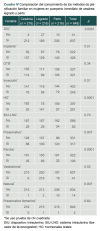[Acceptance of family planning methods in birth, cesarean and curettage]
- PMID: 38016116
- PMCID: PMC11513399
[Acceptance of family planning methods in birth, cesarean and curettage]
Abstract
Background: More than 120 million women worldwide want to avoid pregnancy, but most are not using contraception. This could be because they may not have received clear instructions on how to use the method properly, may not have obtained the most appropriate method for their needs, or may not have been aware of the side effects.
Objective: To compare the acceptance of family planning methods (FPM) in women attended for childbirth, caesarean section, and curettage.
Material and methods: Cross-sectional, analytical, prolective study. Women between 18 and 40 years of age in the immediate puerperium attended at a third level hospital were included. A survey which included 5 items with multiple choice answers and 7 with open answers was applied. General data were gathered, included the acceptance or not of some planning method, and the reason for its use or rejection. In addition, it was identified which methods they knew, if they received counseling and the perspective of effectiveness.
Results: A total of 648 women were included; 216 women in each group. It was found that there is a higher percentage of acceptance of FPM in women attended by cesarean section, compared to those attended by delivery and curettage (p = 0.0158).
Conclusions: Women attended by cesarean section are more willing to approve FPM, compared to those attended by delivery and curettage. Those patients who receive counseling are the most informed and the ones who approve FPM. Nurses and family physicians are the health workers who offer more counseling.
Introducción: más de 120 millones de mujeres en el mundo quieren evitar el embarazo, pero la mayoría no están empleado algún método anticonceptivo. Esto puede deberse a que no hayan recibido instrucciones claras acerca de cómo utilizar el método de manera adecuada, no hayan conseguido el anticonceptivo más apropiado a sus necesidades o no conocieran los efectos secundarios.
Objetivo: comparar la aceptación de los métodos de planificación familiar (MPF) de mujeres atendidas de parto, cesárea y legrado.
Material y métodos: estudio transversal, analítico, prolectivo. Se incluyeron mujeres entre 18 y 40 años que estaban en puerperio inmediato y que fueron atendidas en un hospital de tercer nivel. Se aplicó una encuesta que incluía 5 ítems con respuesta de opción múltiple y 7 con respuestas abiertas. Se tomaron datos generales, la aceptación o no de algún método de planificación, el motivo de su uso o rechazo. Además, se identificaron cuáles métodos conocían, si recibieron consejería y la perspectiva de la efectividad.
Resultados: se incluyeron 648 mujeres, 216 por cada grupo. Se encontró que hay un mayor porcentaje de aceptación de los MPF en mujeres atendidas por cesárea, en comparación con aquellas atendidas por parto y legrado (p = 0.0158).
Conclusiones: las mujeres atendidas por cesárea aceptan más los MPF, en comparación con aquellas atendidas por parto y legrado. Las pacientes que reciben consejería son las más informadas y las que aceptan más los MPF. Enfermería y médicos familiares son el personal de salud que más otorga consejería.
Keywords: Caesarean Section; Cesárea; Childbirth; Curettage; Family Planning; Legrado; Parto; Planificación Familiar.
Licencia CC 4.0 (BY-NC-ND) © 2023 Revista Médica del Instituto Mexicano del Seguro Social.
Conflict of interest statement
los autores han completado y enviado la forma traducida al español de la declaración de conflictos potenciales de interés del Comité Internacional de Editores de Revistas Médicas, y no fue reportado alguno que tuviera relación con este artículo.
Figures






Similar articles
-
Factors associated to Caesarean delivery in public and private health care systems.Rev Esc Enferm USP. 2016 Sep-Oct;50(5):733-740. doi: 10.1590/S0080-623420160000600004. Rev Esc Enferm USP. 2016. PMID: 27982390 English, Portuguese.
-
IUD insertions following cesarean deliveries examined.Netw Res Triangle Park N C. 1984 Winter;5(2):4-6. Netw Res Triangle Park N C. 1984. PMID: 12265941
-
Knowledge about unintended pregnancy shortly after childbirth: An issue of ineffective counseling or adherence?Womens Health (Lond). 2024 Jan-Dec;20:17455057241255655. doi: 10.1177/17455057241255655. Womens Health (Lond). 2024. PMID: 38778791 Free PMC article.
-
Postabortion Care: 20 Years of Strong Evidence on Emergency Treatment, Family Planning, and Other Programming Components.Glob Health Sci Pract. 2016 Sep 29;4(3):481-94. doi: 10.9745/GHSP-D-16-00052. Print 2016 Sep 28. Glob Health Sci Pract. 2016. PMID: 27571343 Free PMC article. Review.
-
Interventions for fear of childbirth including tocophobia.Cochrane Database Syst Rev. 2021 Jul 7;7(7):CD013321. doi: 10.1002/14651858.CD013321.pub2. Cochrane Database Syst Rev. 2021. PMID: 34231203 Free PMC article.
References
-
- Tapia-Curiel A, Villaseñor-Farías M, Nuño-Gutiérrez BL. Conocimientos y actitudes hacia el uso de la anticoncepción de emergencia en jóvenes universitarios. Rev Med Inst Mex Seguro Soc. 2008;46(1):33–41. Disponible en: https://www.redalyc.org/articulo.oa?id=457745519006 . - PubMed
-
- Resolución por la que se modifica la norma oficial mexicana NOM-005-SSA2-1993, De los servicios de planificación familiar. México: Diario Oficial de la Federación; 2004. enero 21, Disponible en: https://dof.gob.mx/nota_detalle.php?codigo=676842&fecha=21/01/2004#gsc.t... .
-
- United Nations, Department of Economic and Social Affairs, Population Division. World Contraceptive Patterns. Serie de información sobre salud y derechos sexuales y reproductivos. Anticoncepción y planificación familiar. Oficina del Alto Comisionado de las Naciones Unidas; 2013. Disponible en: https://www.ohchr.org/sites/default/files/Documents/Issues/Women/WRGS/Se... .
-
- Carbajal-Ugarte JA, Cárdenas-Blanco A, Pastrana-Huanaco E, López-Berrios D. Eficacia y efectos adversos de anticonceptivos hormonales. Rev Med Inst Mex Seguro Soc. 2008;46(1):83–87. Disponible en: https://www.redalyc.org/articulo.oa?id=457745519013 . - PubMed
-
- Garibaldi-Zapatero J, Than-Gómez MT, Guerrero-Rivera S, Cuevas-García CF. Morbimortalidad materna en una unidad de tercer nivel sin servicio de obstetricia. Rev Med Inst Mex Seguro Soc. 2016;54(2):196–202. Disponible en: https://www.redalyc.org/articulo.oa?id=457745149011 . - PubMed
Publication types
MeSH terms
LinkOut - more resources
Full Text Sources
Medical

